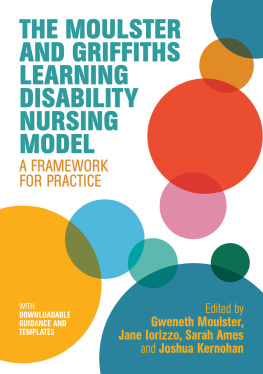First published 1997 by Ashgate Publishing
Reissued 2018 by Routledge
2 Park Square, Milton Park, Abingdon, Oxon, OX14 4RN
711 Third Avenue, New York, NY 10017, USA
Routledge is an imprint of the Taylor & Francis Group, an informa business
Copyright Frank Ainsworth 1997
All rights reserved. No part of this book may be reprinted or reproduced or utilised in any form or by any electronic, mechanical, or other means, now known or hereafter invented, including photocopying and recording, or in any information storage or retrieval system, without permission in writing from the publishers.
Notice:
Product or corporate names may be trademarks or registered trademarks, and are used only for identification and explanation without intent to infringe.
Publishers Note
The publisher has gone to great lengths to ensure the quality of this reprint but points out that some imperfections in the original copies may be apparent.
Disclaimer
The publisher has made every effort to trace copyright holders and welcomes correspondence from those they have been unable to contact.
A Library of Congress record exists under LC control number: 9707 4444
ISBN 13: 978-1-138-62524-2 (hbk)
ISBN 13: 978-1-138-62525-9 (pbk)
ISBN 13: 978-0-429-46006-7 (ebk)
The completion of this study would not have been possible without the support of Richard W. Small, Executive Director. Walker School and Home and Floyd Alwon, Director, Trieschman Center, Needham, Massachusetts. They provided access to the Trieschman Carolinas data base and supported the research project in many ways. Their support is truly appreciated.
I would also like to express my appreciation to Professor Tony Maluccio whom I admire as a scholar and appreciate as a friend. Tonys presence at Boston College drew me to New England and his guidance helped to make this study an interesting and stimulating experience. My thanks are also due to other members of the Boston College faculty Dean June Hopps and Associate Professor Woo Sik Chung whose advice has greatly added to the richness of this study.
The support of my partner Patricia Hansen has also been inestimable.
As we strive to meet the increasingly complex and multiple needs of vulnerable children and adolescents coming to the attention of human service agencies, we continue to appreciate that residential group child care or treatment remains an essential but nonetheless controversial component in an overall continuum of child welfare services (Pecora, Whittaker and Maluccio, 1992:428). It is controversial for such reasons as its high cost, uncertain effectiveness, potential for child abuse and neglect, and frequent use as a placement of last resort. It is essential because it provides opportunities for the nurturing and development of children and adolescents for whom traditional services such as foster care are inadequate, inappropriate, or non-existent.
To achieve its potential as an integral feature of the continuum of child welfare services, however, residential group child care must be redesigned as a support service for families in crisis, rather than continue to be used as a substitute for families. In other words, it must engage families as full and equal partners in the helping process (Pecora, Whittaker, and Maluccio, 1992:424). By doing so, group care can contribute substantially to the goals of contemporary family preservation services, especially the maintenance and enhancement of meaningful and mutually satisfying ties between children and their families as much as possible (Ainsworth, Maluccio and Small, 1996; Warsh, Pine and Maluccio, 1996).
Achieving the goals of family preservation services for children and adolescents in group care is no simple task. In this area of child welfare, parents historically have been regarded with suspicion and disempowered through such means as restrictions on visiting. Moreover, involvement of parents and families has become increasingly complicated due to the severity of the childrens problems as well as the multiple needs and difficulties of parents in areas such as family violence, substance abuse, homelessness, and poverty.
Given this negative context. Frank Ainsworths work on family-centred group care practice is especially welcome, refreshing and promising. Through an original and systematic process, the author has built and empirically validated a child-centred and family-affirming model of group care. The resulting Family Centred Group Care instrument can be used to measure the extent to which residential group care programs are family-centred and to generate strategies for program development. The model clearly builds on prior research, notably child development studies demonstrating the significance of the family in the childs identity formation, psychosocial functioning, sense of competence, and preparation for adulthood.
In line with the recent emphasis on family preservation in the field of child welfare (Nelson and Landsman, 1992), the model reflects a commitment both to care and protection of children from abuse and neglect and the maintenance of connectedness between children and their parents as well as extended family members. Its major components are consonant with the philosophy of family preservation, as they incorporate such aspects as angible provision of services to parents; ongoing involvement of parents with the child, including participation in decision making about the child while in care; and staff acceptance of - and respect for - parents and other family members.
Particularly noteworthy is the models explicit emphasis on embracing and empowering the childs family - especially the parents - as essential resources in the childs treatment, in contrast to traditional group care models that reflect an outdated child rescue philosophy and provide only episodic services to parents. Indeed, as the author indicates, the model serves to reconceptualise group care services for children by firmly locating these programs as part of a family support preservation network that is sensitive to the needs of racially and ethnically diverse families such as those in contemporary U.S. society.
As reflected above, Family Centred Group Care: Model Building makes an original contribution to group care. In particular, the Family Centred Group Care instrument is unique as an empirically-based measurement of a particular model of group care and should stimulate the construction of measures of other program models whose effectiveness for different groups of children can then be examined. In addition, the book suggests a number of implications for practice and research in the broader field of child welfare.
First, in relation to practice, it offers guidelines for the selection of a group care program for specific children and families. It also provides administrators and staff members with suggestions for examining their program, identifying limitations, and strengthening practice approaches. And it offers ideas for the training of staff, particularly child care staff members who are expected to perform major roles in direct work not only with children in care but also with their families.
Second, in regard to research, especially practice-oriented research, Ainsworth inspires further consideration of a range of questions that transcend the development of group care models. These include such issues as the proper relationship among residential group care services, family preservation and family reunification services, and therapeutic foster care; the identification and implementation of the critical ingredients in a family-centred group care program, especially those that promote family continuity and reunification; the matching of children and families to a particular program suited to their needs and qualities; the assessment of outcome and the measurement of success in such a program; and the maintenance of gains in the childs development and functioning in her or his post-placement environment.









